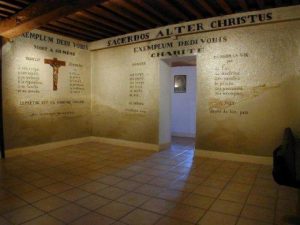Saint-Fons
The Crib, Calvary and the Tabernacle," said Father Chevrier, "are they not the centres to which all men should go to receive life and peace, and from there to go to God" (Le Véritable Disciple, p. 104).

In 1866, after the feast of the Assumption," recounts Father Jaricot, "Father Chevrier took twelve of his children with him - I was one of them - to make a retreat [at Saint-Fons] in this favourite solitude. The small stable was chosen as an oratory and transformed. Father Chevrier put a little Jesus in the cot, similar to the one on the Prado. He began the inscriptions, which he finished later and which can still be seen there. This was our place of meeting and prayer" (Jean-Claude Jaricot, Procès de béatification, t. 3, art. 139).
The context was that of a foundation. "Father Chevrier took twelve of his children with him" to take them away to the mountain of Saint-Fons, where he himself liked to retire from time to time in solitude. The number "twelve" obviously recalls the institution of the Twelve by Jesus on the mountain: "Jesus went up the mountain," writes Saint Mark, "and called to himself those whom he wished. They came to him, and he appointed twelve to be his companions and to send them out to preach, with authority to cast out demons. So he appointed the Twelve" and the evangelist then gives their names (Mark 3:13-19).
 The painting of Saint-Fons, from Le Véritable Disciple. When you open this book that Father Chevrier, founder of Prado, wrote for the formation of his future priests and, more broadly, for all those who wish to follow the path of the Gospel, you notice that he refers several times to the painting of Saint-Fons.
The painting of Saint-Fons, from Le Véritable Disciple. When you open this book that Father Chevrier, founder of Prado, wrote for the formation of his future priests and, more broadly, for all those who wish to follow the path of the Gospel, you notice that he refers several times to the painting of Saint-Fons.
In his study of the Titles of Jesus Christ, speaking of Christ as a "centre towards which everything must converge", he writes: "Are not the cot, Calvary and Tabernacle centres to which all men must go to receive life and peace, and from there to go to God?" (The True Disciple, p. 104).
In his chapter on renouncing one's spirit, Father Chevrier writes: "The saints drew all their inspiration and thoughts from the infinite love of God - God is love - in the cot, on Calvary and in the tabernacle, which are the three great beacons by whose light a true disciple of Jesus Christ must conduct himself" (Le Véritable Disciple, p. 228). We can compare this reflection by Father Chevrier with the words of Jesus in the Gospel according to Saint John: "I am the light of the world: he who follows me will not walk in darkness, but will have the light of life" (John 8:12). This light that is Christ shines out for us particularly in these three places, which are also three successive moments in the destiny of Jesus: the cot, the place and time of his birth; the cross, the place and time of his suffering and death; the Eucharist, the place and time of his presence beyond his death. And here we can already see how paradoxical Father Chevrier's statement is: at Christmas, Jesus, according to the Gospel, was born at night; when Jesus died on Golgotha, darkness, it is said again, had fallen over the earth and, in the Eucharist, the God of the cot and the cross is even more hidden. And yet," says Father Chevrier, "if you fix your gaze there, if you take the time to meditate on these mysteries so that they reveal their full meaning, you will discover that it is here that God's love is most intensely manifested to us.

-----
